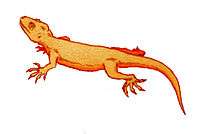Ardeosaurus
| Ardeosaurus Temporal range: Late Jurassic | |
|---|---|
| | |
| Fossil specimen | |
| Scientific classification | |
| Kingdom: | Animalia |
| Phylum: | Chordata |
| Class: | Reptilia |
| Order: | Squamata |
| Genus: | †Ardeosaurus Meyer, 1860 |
| Type species | |
| †Homeosaurus brevipes Meyer, 1855 | |
| Species | |
| |
Ardeosaurus is an extinct genus of basal lizards, known from fossils found in the Late Jurassic Solnhofen Plattenkalk of Bavaria, southern Germany.

Ardeosaurus was originally considered to be a distant relative to modern geckos, and had a similar physical appearance, though more modern phylogenetic analysis has shown it to be a basal squamate outside the crown group of all living lizards and snakes.[1] On the other hand, a subsequent study conducted by Simões et al. (2016) indicated that Ardeosaurus was a stem-gekkotan, corroborating its initial proposed phylogenetic placement.[2] It was around 20 centimetres (7.9 in) long, with a flattened head and large eyes. It was probably nocturnal, and had jaws specialised for feeding on insects and spiders.[3]
References
- ↑ Evans, S. E., Wang, Y., & Li, C. (2005). The early Cretaceous lizard genus Yabeinosaurus from China: resolving an enigma. Journal of Systematic Palaeontology, 3, 319-335.
- ↑ Tiago R. Simões; Michael W. Caldwell; Randall L. Nydam; Paulina Jiménez-Huidobro (2016). "Osteology, phylogeny, and functional morphology of two Jurassic lizard species and the early evolution of scansoriality in geckoes". Zoological Journal of the Linnean Society. in press. doi:10.1111/zoj.12487.
- ↑ Palmer, D., ed. (1999). The Marshall Illustrated Encyclopedia of Dinosaurs and Prehistoric Animals. London: Marshall Editions. p. 86. ISBN 1-84028-152-9.